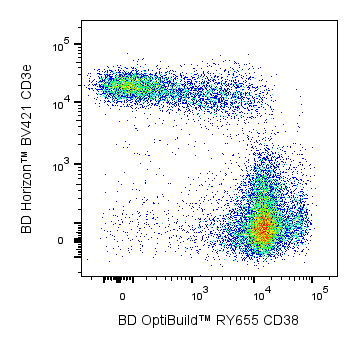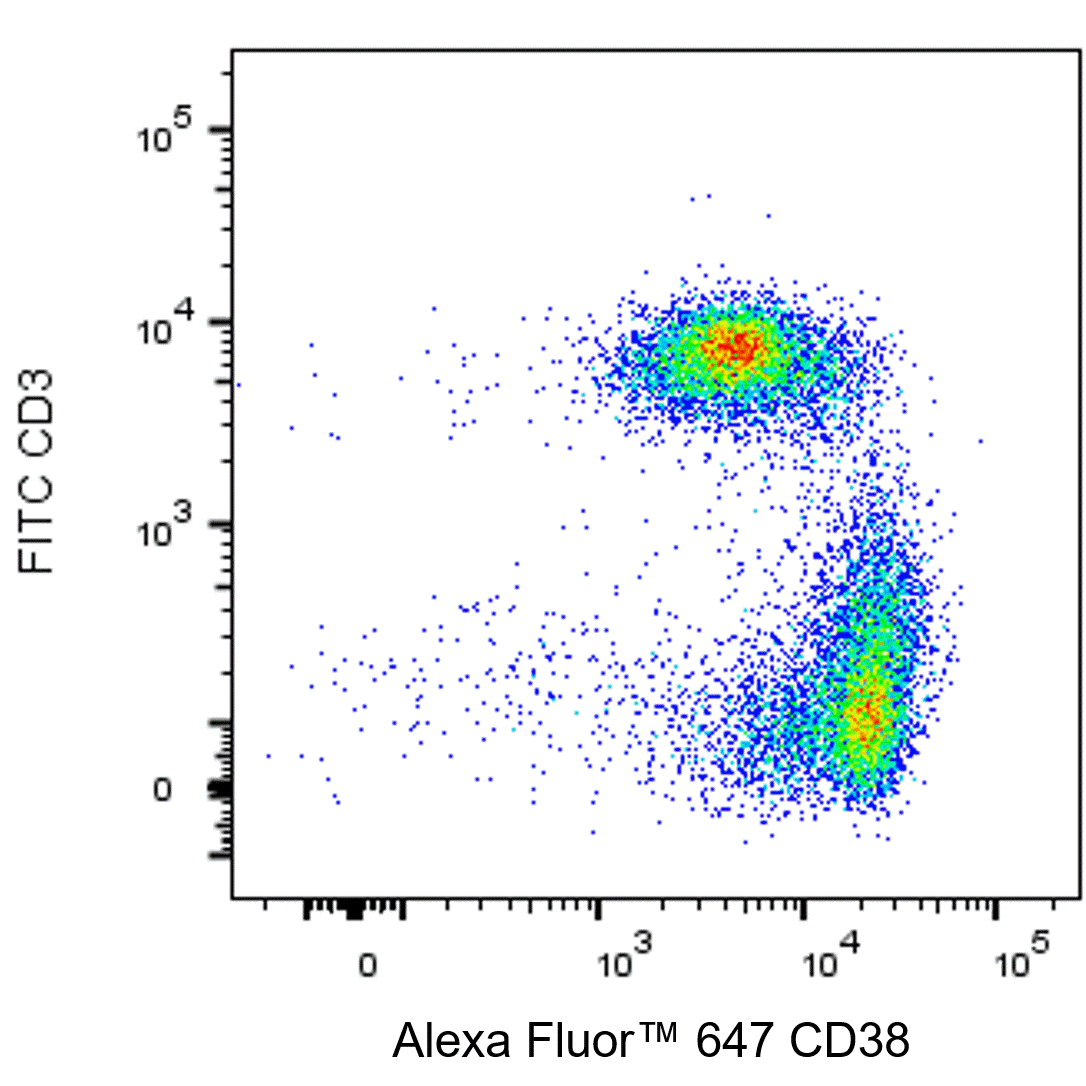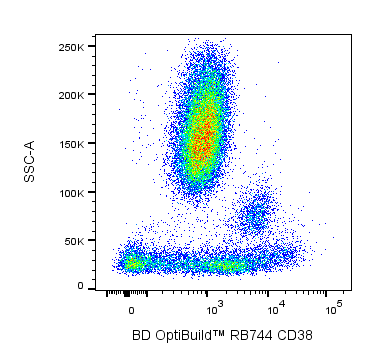-
Training
- Flow Cytometry Basic Training
-
Product-Based Training
- BD Accuri™ C6 Plus Cell Analyzer
- BD FACSAria™ Cell Sorter Cell Sorter
- BD FACSCanto™ Cell Analyzer
- BD FACSDiscover™ A8 Cell Analyzer
- BD FACSDiscover™ S8 Cell Sorter
- BD FACSDuet™ Sample Preparation System
- BD FACSLyric™ Cell Analyzer
- BD FACSMelody™ Cell Sorter
- BD FACSymphony™ Cell Analyzer
- BD LSRFortessa™ Cell Analyzer
- Advanced Training
Old Browser
This page has been recently translated and is available in French now.
Looks like you're visiting us from {countryName}.
Would you like to stay on the current location site or be switched to your location?
CD38 Antibodies
Explore multiple clones against CD38 available for ASR, RUO, and RUO (GMP) use. These antibodies can be used for applications such as flow cytometry, Western blot and Cite-seq against Mouse, Rat and Human targets. Our anti-CD38 antibodies were developed in Mouse and Rat and have Rat IgG2a κ, and Mouse IgG1 κ isotypes. Our CD38-specific antibodies have been used in over 500 articles in peer-reviewed journals. Review over 50 figures from product development to select the best reagents for your needs.
Entrez Gene
Description: The protein encoded by this gene is a non-lineage-restricted, type II transmembrane glycoprotein that synthesizes and hydrolyzes cyclic adenosine 5'-diphosphate-ribose, an intracellular calcium ion mobilizing messenger. The release of soluble protein and the ability of membrane-bound protein to become internalized indicate both extracellular and intracellular functions for the protein. This protein has an N-terminal cytoplasmic tail, a single membrane-spanning domain, and a C-terminal extracellular region with four N-glycosylation sites. Crystal structure analysis demonstrates that the functional molecule is a dimer, with the central portion containing the catalytic site. It is used as a prognostic marker for patients with chronic lymphocytic leukemia. Alternative splicing results in multiple transcript variants.
Description: This gene encodes a non-lineage-restricted, type II transmembrane glycoprotein that synthesizes and hydrolyzes cyclic adenosine 5'-diphosphate-ribose, an intracellular calcium ion mobilizing messenger. The release of soluble protein and the ability of membrane-bound protein to become internalized indicate both extracellular and intracellular functions for the protein. This protein has an N-terminal cytoplasmic tail, a single membrane-spanning domain, and a C-terminal extracellular region with four N-glycosylation sites. Knockout mice deficient for this gene display altered humoral immune responses. In addition, knockout mice exhibit higher locomotor activity and defects in nurturing and social behaviors.
UniProt
Function: Synthesizes cyclic ADP-ribose (cADPR), a second messenger for glucose-induced insulin secretion. Synthesizes the Ca2+ mobilizer nicotinate-adenine dinucleotide phosphate, NAADP+, from 2'-phospho-cADPR and nicotinic acid, as well as from NADP+ and nicotinic acid. At both pH 5.0 and pH 7.4 preferentially transforms 2'-phospho-cADPR into NAADP+, while preferentially cleaving NADP+ to cADPR and ADPRP rather than into NADDP+ . Has cADPR hydrolase activity .
Molecular Function: Hydrolase, Receptor, Transferase
Subcellular location: Cell surface, membrane
kDa: 34
Function: Synthesizes the second messengers cyclic ADP-ribose (cADPR) and nicotinate-adenine dinucleotide phosphate (NAADP), the former a second messenger for glucose-induced insulin secretion, the latter a Ca2+ mobilizer. Also has cADPR hydrolase activity
Molecular Function: Hydrolase, Transferase
Subcellular location: Membrane
Protein Family: ADP-ribosyl cyclase family
kDa: 34
AKA
I-19, ADPRC 1, Cd38-rs12'-phospho-ADP-ribosyl cyclase, 2'-phospho-ADP-ribosyl cyclase/2'-phospho-cyclic-ADP-ribose transferase, 2'-phospho-cyclic-ADP-ribose transferase, ADP-ribosyl cyclase 1 (ADPRC 1), Cyclic ADP-ribose hydrolase 1 (cADPR hydrolase 1), NIM-R5 antigen, ADPRC1, cADPR1, ADPRC 12'-phospho-ADP-ribosyl cyclase, 2, T1
SAMPLE DATA
Our antibody reagents portfolio is designed for exceptional specificity, sensitivity, and consistency to empower researchers to generate high-resolution, reproducible data with confidence. The figures below showcase antibody performance in relevant model systems, highlighting minimal background staining and robust signal-to-noise ratios. Whether you’re studying rare cell population or scaling up for high-throughput analysis, our reagents are designed to elevate and standardize your flow cytometry experiments.

Samples were acquired using the BD FACSymphony™ A5 SE Cell Analyzer and analyzed with FlowJo™ v10.8 Software.

Flow cytometric analysis of CD38 expression on Rat splenic leukocytes.

Samples were acquired on the BD FACSymphony™ A5 SE Cell Analyzer.

Multiparameter flow cytometric analysis of CD38 expression on human peripheral blood leucocyte populations.
PANELS
Accelerate your research with our pre-designed antibody panels optimized for flow cytometry. Our panels offer the precision and convenience you need to move quickly from data to insight. Our immunology experts designed these panels for comprehensive immunophenotyping, enabling accurate identification and characterization of a variety of immune cell types.
COLLATERAL
Maximize the impact of your flow cytometry experiments with our comprehensive suite of support materials. From detailed protocols for experimental setup to academic posters showcasing real-world applications, our resources are designed to help you uncover the full potential of our antibodies. Explore product flyers and brochures that highlight key features, performance data, and use cases; deepen your expertise through educational webinars led by our immunology and flow cytometry specialists. Whether you're new to flow or optimizing complex panels, our collateral empowers you to generate high-quality data and drive meaningful discoveries.
Shop Our CD38 Antibodies Products
For Research Use Only. Not for use in diagnostic or therapeutic procedures.